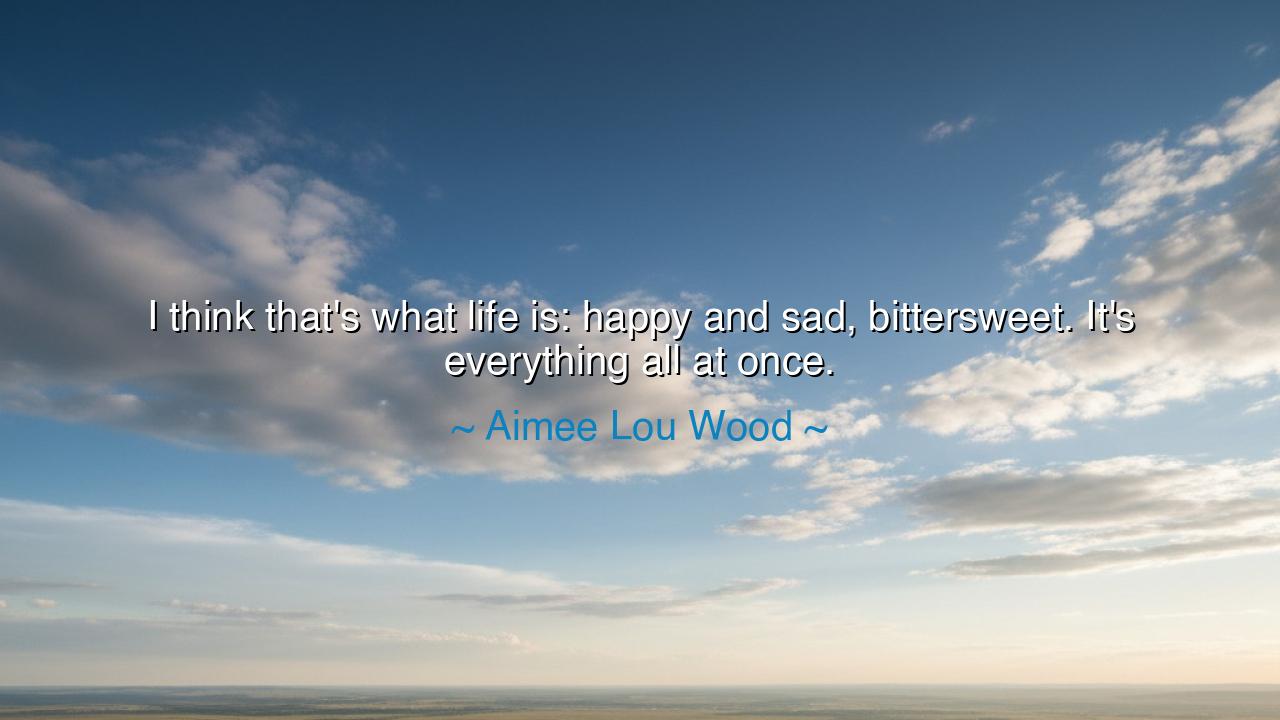
I think that's what life is: happy and sad, bittersweet. It's






In the words of Aimee Lou Wood, we hear a reflection that captures the very essence of existence: “I think that’s what life is: happy and sad, bittersweet. It’s everything all at once.” This is no casual thought, but the distilled wisdom of the human condition. For life is not one thread, but a tapestry woven of countless colors—bright and dark, joyful and sorrowful, woven so tightly together that to pull one strand is to touch them all. To live is to feel the fullness of this mingling, where sorrow deepens joy, and joy softens sorrow.
The ancients themselves knew this truth and sang it in their myths and poetry. The Greeks spoke of Eros and Thanatos—love and death—as forces forever intertwined. The great tragedies of Sophocles and Euripides were not written to plunge men into despair, but to remind them that joy and suffering share the same soil. In the laughter of the feast and the tears of mourning, the people felt themselves fully alive. Aimee Lou Wood’s words echo this ancient understanding: that the beauty of life is not in purity of one feeling, but in the blending of many.
Consider the life of Helen Keller, who lived in darkness and silence, yet found joy in knowledge and connection. To her, the world was both cruel and magnificent—filled with limits, but also radiant with discovery. She wrote often of the bittersweet nature of life, saying that though she knew sorrow, it made her joy more profound. In this way, she embodied the truth of Wood’s quote: that life’s fullness is not found in the absence of sadness, but in the courage to embrace both sorrow and delight.
We may also look to the story of Nelson Mandela, who endured decades of imprisonment, torn from family and freedom. Yet when he emerged, he did not live in bitterness, but in joy, reconciliation, and laughter. His life was not simply triumph nor simply tragedy—it was everything all at once. He carried the pain of his suffering and the happiness of his victory together, and in that union, he became a figure of immense strength and compassion.
The lesson is this: do not fear the bittersweet nature of life. Too many seek only joy and recoil from sadness, but in doing so, they numb themselves to the depth of both. To embrace the whole of life is to understand that sorrow carves the heart into a vessel large enough to hold joy. The one gives meaning to the other. Without sadness, happiness is shallow; without joy, sorrow is unbearable. Together, they form the wholeness of being human.
Practically, this means living with openness. When happiness comes, embrace it fully without fear of its end. When sadness comes, accept it without shame, knowing it is part of the same river. Write of your feelings, share them with loved ones, and allow yourself to feel everything—for in this, you become more alive. Let go of the illusion that life must be constant joy or constant ease. Instead, find strength in the dance of opposites.
And so, let us take Aimee Lou Wood’s words as wisdom for our own journeys: life is not one note, but a symphony of both major and minor chords. To live is to welcome both laughter and tears, to walk with hope even when sorrow shadows the road. Do not shrink from the bittersweet—for it is the taste of life itself, rich, deep, and eternal.






AAdministratorAdministrator
Welcome, honored guests. Please leave a comment, we will respond soon